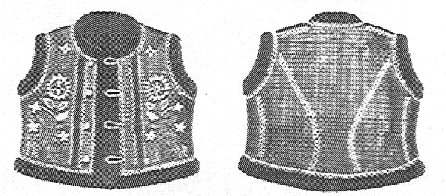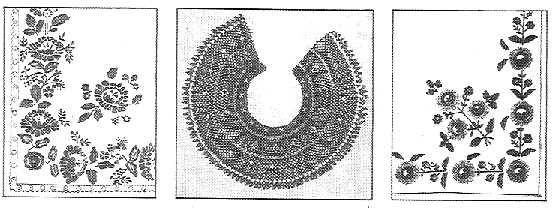
The following article, authored by Ivan Krasovs'kyj, first appeared in Carpatho-Rusyn
American, Volume 10 #3, 1987
Copyright © 1987 and is used here
with permission
This article is written by Ivan Krasovs'kyj, a Lemko historian-ethnographer and curator of the Lemko section in the open-air folk museum in L'viv, Soviet Ukraine. The article was translated from Ukrainian by Jurij Shkljar and appears here with the courtesy of the Ukraina Society in Kiev. - Editor
Clothes worn by Lemkos have always fascinated outsiders by their striking variety of designs and color patterns. Until the mid-nineteenth century, Lemkos made their garments from homespun linen and heavy, coarse cloth. Later, the intrusion of commercial manufacture into the peasant's daily life had an impact on the evolution of clothing as well. Cheap factory-made fabrics gradually replaced homemade garments, although the latter retained traditional folk designs.
Lemko women generally wore underclothes consisting of a sorochka (blouse) and a spidnyk (underskirt), also known as a podolok. On holidays, they put on fine linen blouses and weekdays they wore ones made of coarser konipne fabric. These blouses were generally short, 20-24 inches. In the eastern Lemko Region, the blouses were tucked into the skirt; farther west they were sewn onto the skirt. A typical blouse from the Sanok district had a stiff collar. Beneath it, the cloth was pleated, with three-row embroidery (tryrjadka) done in bracket (lapky) and square-stitch (kvadratyky), using blue and red threads and embellishing the sleeves below the shoulders. Toward the edge, the sleeves were also pleated. The cuffs were narrow, decorated with three-row embroidery and a pointed overhand stitch at the end (zubci). Blouses made in the central Lemko district of Jaslo had somewhat broader solid sleeves with multicolored needlework in the lower part. The broad cuffs boasted embroidered leaves, twigs, and flowers, and ended in slits trimmed with colorful overhand.
The outer garments included a skirt, known as the kabat or fartuch, with a small fartushok or zapaska (literally, apron, but here that part of woman's dress which serves as a skirt). The skirt proper was wide, pleated at the waist, with the straight folds pleated still more at the bottom. Until late in the nineteenth century, dresses worn every day were unornamented, whereas holiday garments boasted needlework in the form of sun-shaped, curved, flower, and leaf-styled patterns. these were done in blue or brown thread. Designs were first carved on a wooden board. The board was then covered with a fine layer of dye and an imprint made upon a length of cloth. Such a print dress was called a maljovanka or farbanka. As factory-made fabrics found their way to the countryside, these farbanka dresses gradually disappeared.
In a description of the Lemkos from 1841, the Galician Ukrainian ethnographer Ivan Vahylevych claimed that Lemko women even then wore calico finely-pleated skirts in summer, but come winter they put on those same homemade farbanka dresses. Along the border with the Boyko Region in the east, Lemko women dressed in colorful skirts. Those worn by unmarried girls were blue, red, and pink; those by married women were green; and those by widows were black. In the central and western parts of the Lemko Region, the nyz or solid stitch was used to sew narrow colorful stripes on women's skirts. The front from the belt down was a hand's length from the hem under the zapaska skirt and was made from a wedge of homespun linen.
The "shoulder garments" consisted of a lajbyk, korset (bodice), kozushanka (sheepskin vest), kozhushok (short sheepskin coat), serdak (peasant's coat of coarse wool), and hunka (jacket). The lajbyk was a kind of sleeveless waistcoat made of blue coarse cloth, decorated with multi-colored laces and buttonholes.
A popular variety of the sleeveless jacket is found in the korset (korsetca) bodice, which was made of dyed coarse cloth, silk, or velvet, and lined with homespun linen . Its bottom section, from the belt to the hem, ends in semicircular wedges (klynci) or flaps (klapany), and the korset bodice was more often than not buttoned up. Throughout the Jaslo district and in the outskirts of the towns of Nowy Sacz and Gorlice, korset bodices were embroidered with colorful threads and laced with tiny shining plates and flower-shaped beads.
Sometimes, a Lemko woman would put a sheepskin jacket (kozhushanka) on top of the blouse. This jacket was designed to resemble the korset bodice, but without the wedges (flaps) at the bottom. This garment was widespread in the central part of the Lemko Region. It was made of cherry-colored velvet, lined by homemade coarse cloth or linen. The edges were trimmed with black sheepskin or other differently dyed material. It was embellished by a couple of bouquets of various color and embroidered on the chest. In the Sanok district, women used to wear short yellow sleeveless wool-lined jackets. The edges were complete with the baranok (lamb) stitch. Floral needlework brightened up the chest.

A sheepskin jacket (kozhushanka) with boquet pattern on front and lamb stitch (baranok) on edges. (Photo courtesy of the Ukraina Society, Kiev)
The serdak (woolen coat) and hunka (jacket) were made of homespun linen. An unlined serdak-- loose and of simple cut -- was ornamented by colorful sewn-on laces. The hunka was a jacket with different kinds of lining. It was worn on cold days. Its collar, the ends of its sleeves, the lower and front edges, the trimming of the pockets were covered with white or blue factory-made coarse cloth, or with red or green woolen laces, called suknjat. Down the back there were falda (slits). In the eastern Lemko villages, the hunka was made of black or gray coarse cloth, while in the western Lemko villages, similar garments were made of white cloth. These jackets were either buttoned up or fastened with wire hooks. Lemkos used to wear hodaky or kerpci, shoes made of two rectangular pieces of rawhide tied to the feet with woolen strings known as navoloky. On Sundays and on holidays they wore Hungarian fancy boots with high legs. Lemko women covered their heads with pieces of white cloth. Elder women wore big babushkas which they knotted at the back or folded up, throwing the rest of the cloth over the shoulders. A babushka was often decorated with small flowers, the edges trimmed by colorful patterns. The part that hung from the back featured a large embroidered flower whose design was in each case decided by the craftswoman.

The hardan , worn around the neck. (Photo courtesy of the Ukraina Society, Kiev)
Lemko women and girls also used to wear krajky and other strings of beads. A krajka necklace was braided, using strings of different beads and forming a band with a vegetative ornament that was fastened round the neck. The hardan represented a more sophisticated design, having a network of whimsically-braided colorful beads. Korali (literally, corals) were strings of beads tied round the neck, consisting of some 10 to 15 strings varying in length. These were either red (genuine sea-bred corals) or cheap glass imitations. After World War II, the practice and trades of working wool and making fiber began noticeably to decline. It was at that time that traditional Lemko garments were discarded. In the Soviet Union, only Lemko women in far northwestern Transcarpathia (Subcarpathian Rus') have persisted in wearing the traditional dress for daily use. Among other Lemko immigrants in the Soviet Union, it is only in folk ensembles that traditional dress is worn, as in the Lemko choirs from the villages of Loshniv (Ternopil' region) and Rudne near L'viv.
Ivan Krasovs'kyj
L'viv, USSR